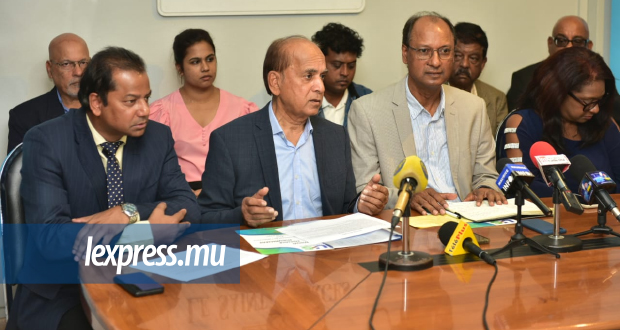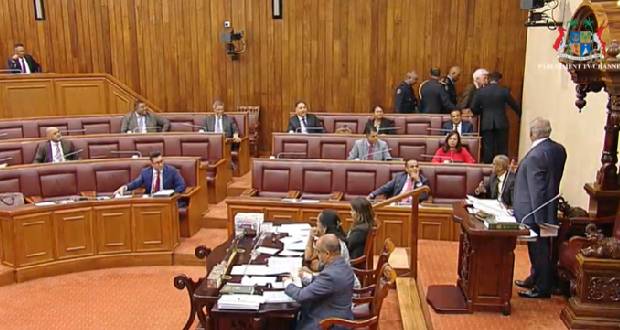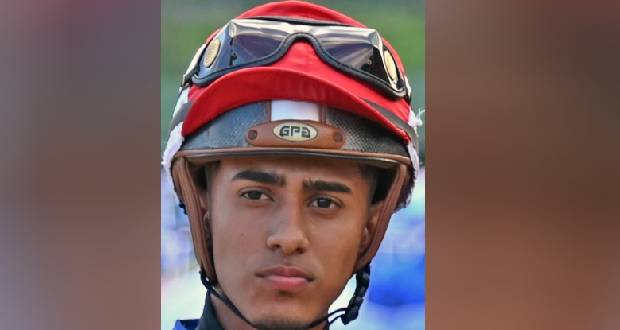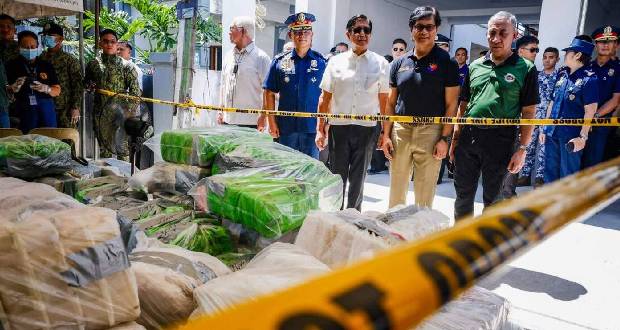Publicité
What the expedition to Blenheim Reef really means…
Par
Partager cet article
What the expedition to Blenheim Reef really means…

For the first time, the Mauritian government has organized a boat trip to the Chagos archipelago under the guise of a scientific expedition to chart Blenheim Reef. But what is the significance of this expedition, why is Blenheim Reef being charted, and what does the trip tell us about Mauritius’ strategy?
1.The expedition
The Mauritian government has organized a scientific expedition to the Chagos archipelago, led by its UN permanent representative Jagdish Koonjul, marking the first such visit organized by the Mauritian state. “It’s a good exercise in public relations because it creates awareness about the dispute,” says Milan Meetarbhan, former UN permanent representative, “but there has to be consistency and good faith throughout.”
The 15-day expedition organized by Port Louis comes as the latest in a series of political and legal reversals for the UK and its claims over the Chagos, which it calls the British Indian Ocean Territory (BIOT) and which it excised from Mauritius back in 1967 and proceeded to depopulate by 1973 to make way for a US military base on Diego Garcia, the largest atoll in the island chain. In 2015, an arbitral tribunal under the United Nations Law of the Sea (UNCLOS) ruled against the UK unilaterally declaring the Chagos to be a marine-protected area. Then in 2019, the International Court of Justice (ICJ) in an advisory opinion ruled that the decolonization of Mauritius remained incomplete and termed the UK’s continued management of the Chagos to be “unlawful”. That was swiftly followed by a resolution in the UN’s General Assembly demanding that the UK “withdraw its colonial administra- tion from the Chagos archipelago unconditionally within a period of no more than six months”.
The UK ignored that deadline. Then in 2021, the International Tribunal of the Law of the Sea (ITLOS), currently hearing a maritime boundary dispute between Mauritius and Maldives dismissed the latter’s objections that the UK was a party to the dispute and relied on the ICJ decision to deny that London exercised sovereignty over the Chagos. “The whole strategy of various Mauritian governments has been to approach this issue from a slight angle. First challenging the MPA, then the ICJ. It has been a strategy that has been paying off in the long run,” says Ram Seegobin of Lalit.
Aside from further underscoring Mauritian rights over the Chagos, the ostensible purpose of the expedition was to visit and study the 36.8-km Blenheim Reef in the Chagos, which remains unclaimed by the UK but has been recognized as part of the Chagos by Mauritius since 1975.
2. The dispute with Maldives
More than just embarrassing London, the expedition has more to do with the ongoing maritime boundary dispute between Mauritius and Maldives at the ITLOS. Both countries claim an area of 95,828 km2 of sea that overlaps between what Maldives claims is its southern maritime boundary and what Mauritius says is the northern maritime boundary of Chagos. Both states went to the ITLOS after failing to settle the issue since starting talks over the dis pute in 2010 and after both submitted competing maritime - claims at the UN. The timing of the expedition is important given that the ITLOS, on December 15, 2021, gave Mauritius the deadline of April 14 to submit its reply to the Mal dives, and the deadline of August 15 for Maldives to submit - a rejoinder to the Mauritian case.
Now, why is the expedition studying Blenheim Reef? That has to be with how the UNCLOS defines an island. According to section 121 of UNCLOS, an island is a naturally established land area that stays above water at high tide. What the expedition is looking to figure out is whether any of the four islets on the eastern side of Blenheim Reef stay above water at high tide and thus qualify as islands under the UNCLOS definition.
This is important because of the different interpretations of UNCLOS that Mauritius and Maldives have presented at the ITLOS. Since at least 1975, the Mauritian foreign minis- try position has been that its territorial waters should be drawn around a 200 nautical mile zone starting from outlying islands in its territorial waters, no matter how small. Therefore, should even a small part of the Blenheim Reef stay above water at high tide – and prove to be an island under part of the UN CLOS definition – Mauritius can claim an additional 4,800-- km maritime zone around the Chagos.
By contrast, the Maldivian interpretation of UNCLOS is a 200-mile maritime zone can only be declared around populated islands, not uninhabited outer islands. So, when it comes to the Chagos, the 200-mile zone should be counted around only Diego Garcia, the only island in the chain hosting its own population in the form of the US military base there. According to the Maldivian interpretation, therefore, the EEZ around the Chagos should not be counted as from outlying islands such as Peros Banhos, Salomon – still less, Blenheim Reef, should it stay above water at high tide – and therefore, that the EEZ around the Chagos should be 10 percent smaller, and that of Maldives, by consequence, 10 percent bigger.
This is why Maldives has positioned itself against Mauritius when it came to the vote on the Chagos at the UN General Assembly in 2019 – Maldives was only part of a handful of countries including the US, UK, Australia, Hungary, and Israel to vote against Mauritius. And this is also why on February 7, the Mauritian government in a statement lamented the - fact that the Maldives did not allow the expedition to Blenheim reef and the outer islands of the Chagos to leave from its ports. This is also why the expedition had to leave from Seychelles, who since the return of Aldabra, Farquhar, and Desroches islands in June 1976, has no outstanding claims on the Chagos or its waters.

Although the expedition to Blenheim Reef may look to prove that it is more than just a low-tide elevation that cannot be claimed by Mauritius or generate claims on the waters around it, whether this will lead to the ITLOS de ciding this question according to the Mauritian interpretation of UNCLOS remains to be seen. “This is not always for the coastal state to determine,” Meetarbhan explains, “while geographically it makes sense for us to use it to set the outer limit of our maritime boundary, this is a matter for international law and whether or not Blenheim Reef fulfils the conditions for an island set out under the UNCLOS.”
3.The stopover at Peros Banhos and Salomon
Aside from Blenheim Reef and its implications for the Mauritian case at the ITLOS, the Bleu de Nîmes carrying the 25-strong expedition stopping over at Peros Banhos and Salomon – and raising a Mauritian flag at Peros Banhos – is steeped in diplomatic symbolism. This is not the first such trip to be proposed to the Chagos: back in 1979, the MMM proposed a similar expedition, which was rejected by the then-Mauritian government. And more recently, in 2004, the left-wing party Lalit proposed launching a ‘peace flotilla’ to the Chagos. “Our idea at the time was much more provocative action along the lines of what Greenpeace does,” recalls Seegobin. Nor is this the first time that Chagossians have been ferried to the Chagos. Between November 2017 and September 2020, London has taken 154 Chagossians to the islands on what it calls ‘heritage visits’ to curry favour among Chagossian groups scattered in Mauritius, Seychelles, and the UK.

This, however, is the first time that the Mauritian state itself has organized such a visit as stated by Prime Minister Pravind Jugnauth when in a recorded message he pointed out that “this is a historic visit because it is the first time since our independence that, as a state with sovereign rights over the Chagos Archipelago, we are able to organize a trip to this part of our territory”. Going to Blenheim Reef – not formally claimed by the UK since it drew a ‘median line’ between what it termed to be the maritime boundary between what is considered to be Maldivian and BIOT waters. “But stopping at Peros Banhos and Solomon which are formally claimed by the UK to be part of the Chagos has a completely different significance,” says Meetarbhan.
However, the fact that the expedition limited itself to the outlying islands of Peros Banhos and Salomon also indicates how each party in the dispute has come to settle on how it sees the end of the dispute between Mauritius and the UK. London commissioned two studies looking into the feasibility of resettlement of the Chagossians on the islands. A first study in 2002 concluded that resettlement was not feasible while a second study conducted by the firm KPMG in 2015 argued that resettling the Chagossians on outlying islands was feasible. Such studies have influenced the strategy of the fractious Chagossian groups split between Mauritius, Seychelles, and the UK. In a series of court cases in the UK starting as from 1999, the Chagossians have demanded that British courts allow them to be resettled on the Chagos as British citizens on so-called British territory.
What this means is that far from contesting the US base on Diego Garcia, many of these groups have limited themselves to demanding to be allowed to resettle on the outlying islands such as Peros Banhos and Salomon. In their view, the US base staying would actually help in setting them up economically in the Chagos. Between August and October 2015, the UK’s Foreign and Commonwealth Office conducted consultations with 832 Chagossians around the globe and found that 70 percent of them wanted to be allowed to work on the US military base – displacing some of the 2,000 or so mainly Sri Lankan and Filipino workers currently servicing the base. This would explain why there was little pressure from the Chagossians themselves to push onto Diego Garcia.
4.The shifting Mauritian position
That the expedition limited itself to visiting these two outlying islands while steering clear of Diego Garcia also in- dicates to what extent the Mauritian position on the Chagos also seems to have shifted. While the question of the Chagos has birthed some unchanging verities within the Mauritian foreign policy establishment: Port Louis has consistently refused to recognize Kosovo that was carved out of the former Yugoslavia out of fears of the precedent that can set for the Chagos that was carved out of it in 1965. And despite the former Labour Party government saying it would recognize Kosovo in 2009, nothing has been done as yet.
But within its stance on the Chagos, much has shifted in the past two decades. After the end of the Cold War in 1991, when Mauritian demands to return the Chagos were rebuffed and Diego Garcia became more important to US policy in the Middle East and to safeguard global shipping in the region, successive Mauritian governments looked to maximize their chances of getting the Chagos back by courting the US while focusing their ire on the UK. So in 2004, the then-Mauritian government stated that it had no problem with the US keeping its base on Diego Garcia and even proposed a treaty in 2006 for the handing back of the outlying islands such as Peros Banhos and Salomon similar to how Farquhar, Aldabra, and Desroches were handed back to Seychelles in 1976. In 2008, Mauritius offered a deal to the US to keep the base on Diego Garcia. On July 11, 2017, the Mauritian government even sent a letter to the US administration led by Donald Trump stating its support for the base on Diego Garcia to stay.
These however were conducted on backchannels. But in 2019, Mauritius went public with its offer with its representative at the UN Jagdish Koonjul announcing that it was ready to sign a 99-year lease with the US for Diego Garcia, beating the current lease between the US and the UK, which expires in 2036. In June 2020, during a talk at the US-based think-tank CNA, Koonjul reiterated his offer and at the same event stated that Mauritius was willing to water down its interpretation of the anti-nuke Pelindaba Treaty to mean that ships on Diego could continue to carry nukes so long as they were not permanently stationed on the base. The desire to keep the base on Diego Garcia, he maintained, was something that all mainstream political parties in Mauritius agreed on.
So, the current Mauritian-sponsored expedition, focusing on the outlying islands such as Peros Banhos and Salomon, but steering clear of Diego Garcia seems to confirm that like some of the Chagossian groups, Mauritius too has come to accept limiting its ambitions to the outlying islands. “If you listen to what Mauritian representatives say, there seems to be a consensus that we should concentrate on outlying islands and negotiate for them only and not disrupt the security arrange- ment in the Indian Ocean,” concludes Seegobin, “and with the expedition only visiting outlying islands, things seem to be heading that way.”
And Meetarbhan adds, “We need a series of cumulative actions to bring everybody to the negotiating table and these have been done over the past 12 years. This expedition is one of those actions.”
Publicité






